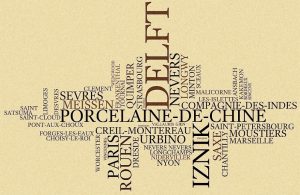Ceramic
The term ceramic encompasses all objects in clay, fired at different degrees.
Those combinations of materials and cooking determine a classification according to the porosity of the pieces.
The higher the firing is, the more waterproof the paste is. Then, terracotta and earthenware necessitate enameling to make them waterproof.
It’s not necessary for bone china and sandstone, which are naturally glazed.
Classification
Alexandre Brongniart, who was at the head of the Manufacture of Sèvres for 47 years, classifies the different ceramics according to their porosity. This typology, determined in 1854 in the “Traité des Arts céramiques ou des Poteries”, evolves according to the historical and scientific discoveries.
Ceramic includes four main families determined by the chemical compositions of the pastes and glazes, which are also subdivided in several families :
- Terracotta
- Earthenware
- Bone china
- Sandstone
Good knowledge of those different materials is essential to restore objects according to their possible chemical reactions during the intervention.
Actually, there is a countless variety of technics behind this simplified classification. Restoring is very research intensive. Thus, each item is a specific case.

